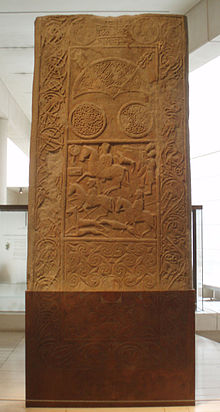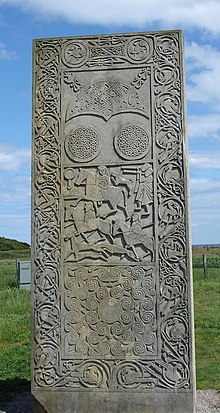Hilton of Cadboll Stone


TheHilton of Cadboll Stoneis a Class IIPictish stonediscovered atHilton of Cadboll,on the East coast of the Tarbat Peninsula inEaster Ross,Scotlandand now in theNational Museum of Scotland.It is one of the most magnificent of allPictishcross-slabs. Until its felling in a storm in 1674, it faced East - West in a natural amphitheatre about 100m from the shore, which runs NE - SW. Like other similar stones, it can be dated to about AD 800.
Until the base of the stone was discovered during archaeological investigations in 2001, the original orientation of the stone had been lost. When a copy was erected in 2000 close to the original site, the face with the hunting scene was placed facing West. The discovery of the lower portion of the original stone showed that the face with the hunting scene faced East and that the West face bore a cross with a stepped base.[1]In accordance with convention, the face with the cross will be referred to as the front and the face with the hunting scene as the back.
On the front of the stone was aCalvary crosswith figures concerned with Death, Judgement, Heaven and Hell.[2]On the back there is avine-scrollborder (representing the Eucharist) to the left, right and bottom and the Pictish symbols ofdouble disc and Z-rodat the top. Within are three square panels:
- In the top panel are the Pictish symbols ofcrescent and V-rodabove two circular discs containing knotwork.
- The middle panel shows a hunting scene featuring a prominent person on horseback face-on wearing a largepenannular brooch.For many years this was regarded as a secular scene with the prominent person a female aristocrat. Modern scholarship[3]identifies the scene as a derivative of the RomanAdventusand the prominent person asChrist.The deer being harried by two hounds at the bottom of the panel referencesPsalm 42,in which the deer is likened to the soul thirsting for salvation. Psalm 42 was sung on theEaster vigilwhencatechumenswere preparing to beBaptised.
- The bottom panel was broken in half when the stone fell in 1674 and only the top half is in the National Museum of Scotland. It is a scrollwork design featuringtriskeleswhich has been adopted by the neighbouring whisky distillery,Glenmorangie,as its logo. After the base of the stone was discovered in 2001, the central portion of the panel was reconstructed from flakes excavated from the field of debris around the base. This showed that at its centre was a cross similar to that on the east face of theEdderton cross-slabbut with equal arms and that the scrollwork design emanates from four points (NE, SE, SW, NW) on a circle surrounding the cross. The panel has now been identified as representing thefour rivers of paradisespringing from the cross[4].
In the thirteenth centuryHilton of Cadboll Chapelwas built 6m to the East of the stone.
In a letter[5]Sir George MacKenziereported that the wind on 21 December 1674 had been extraordinary and that
it broke a standard-stone that stood as an obelisk near an old church it was high about 12 foot, broad 5 and towards two foot thick
The stone which is in the museum today is the top three-quarters of the original stone: the dark part at the bottom of the image is a copper housing which shows what the bottom quarter would have looked like.
The bottom of the stone, below the break, remainedin situat Hilton of Cadboll and was found during the archeological investigation in 2001. It is now on display at theJohn Ross Visitor CentreinBalintore.Its cross-face shows a stepped base with bosses (similar to those on the stones atShandwickandNiggbut with bipartite spirals) while on the reverse face the vine-scroll bottom border is very similar in style to thefragment of a cross-slab known as Tarbat 1.This was found near the site of the Pictish monastery atPortmahomackand is also now in the National Museum of Scotland.
The top three-quarters of the stone had its cross-face erased and a memorial dated 1676 inscribed to Alexander Duff and his three wives. The slab appears never to have been used and was left in Hilton when Duff was later buried inFearn.Antiquarian interest in the stone began in the late eighteenth century when RevCharles Cordinerwrote about it inAntiquities and Scenery of the North of Scotland,London, 1780and illustrated it inRemarkable Ruins and Romantic Prospects of North Britain,London, 1788–95.
The land on which the stone lay was part of the Cadboll estate which was owned by the Macleods of Cadboll. They removed it in the late 1860s to be a feature in the garden of their seat atInvergordon Castle.An early postcard of it there shows it to have been in good condition then. In 1903Romilly Allenreported it to be weathering rapidly in its exposed position.[6]In 1921 Macleod of Cadboll sold Invergordon Castle and offered the stone together with Tarbat 1 to theBritish Museum.They were transported there and accepted subject to approval by the Trustees. A rearguard action by the Scottish antiquarian establishment succeeded in deferring the Trustees' acceptance and their releasing Macleod of Cadboll from his gift so that he could redonate the stones to theNational Museum of Antiquities of Scotland,which he did.
In the 1990s a campaign to return the stone to its original location having failed, a full-scale copy of the stone was commissioned from local sculptor Barry Grove. During 1998-9 he carved the back and the stone was erected in 2000 close to its original location with the front blank.
Meanwhile during 1998 excavation in the vicinity of the Hilton of Cadboll chapel site was undertaken by Kirkdale Archaeology (Paul Sharman and Jon Triscott) on behalf ofHistoric Scotland.During this work approximately 40 fragments of carved micaceous sandstone were recovered; the likely origin for these was surmised to be from the lost cross face of the Hilton of Cadboll stone.
Subsequently, in 2001, Historic Scotland commissioned Kirkdale Archaeology (Dave Murray, Stuart Jeffrey, Meggen Gondek, and Angus Mackintosh) to undertake a further excavation. Assisted by Barry Grove, a further 740 carved sandstone fragments, and 122 possibly carved fragments, were recovered. In addition, the missing lower portion of the cross-slab was discovered (by Angus Mackintosh), but leftin situ.
Later in 2001 the lower portion of the cross-slab, along with several thousand more carved fragments, was recovered byGlasgow University Archaeological Research Division(GUARD) during an excavation funded by Historic Scotland. The presence and distribution of these fragments suggests that the original intention had been to dig out the entire stone and that, possibly many years after this had failed, defacing of the cross beganin situ.In a storm the stone fell towards the chapel, breaking as it fell and leaving the cross-face uppermost. Defacing later continued with the stone now on the ground.
Analysis of these fragments led to the reconstruction of parts of the lost cross-face. Together with the now-lifted lower portion of the slab this enabled Isabel Henderson to use art-historical analysis to infer the iconography of the cross-face. This informed Barry Grove's carving of the front of the modern copy during 2003-5.
Following some controversy, it was accepted that ownership of the lower portion of the original cross-slab lay with the National Museum of Scotland but that it should be displayed in Hilton of Cadboll village hall rather than joining the upper portion in Edinburgh. In parallel with the excavation, Historic Scotland also funded research carried out by ProfessorSian Jonesof theUniversity of Manchesterinto the significance of Early Medieval Sculpture to local communities which concentrated on the historical fragmentation and movement of the Hilton of Cadboll monument as well its modern role in the production of meaning, value and place,[7]The excavation and subsequent analysis of the 'biography' of the monument was the foundation of a major monograph published by theSociety of Antiquaries of Scotlandin 2008.[8]The digital elements of the excavation archive were deposited with theArchaeology Data Service.[9]

Only one skeleton was fully excavated and removed; the others remained undisturbed throughout the duration of the fieldwork. The burials contained various types of pottery and some stones with an unknown glaze on the surface. Several metatarsals were removed for radiocarbon dating, but were returned to the site once testing was complete.
Ten soil samples were taken from the site which appeared to contain charcoal or other evidence about the environment. These samples were subjected tooptically stimulated luminescence(OSL) dating coupled with the analysis of thestratigraphyin order to establish the age and content of the soil. Five distinct levels were discovered in the soil which date from 9th century to present day.
Notes
[edit]- ^James, Heather; Henderson, Isabel; Foster, Sally; Jones, Siân (2008).A Fragmented Masterpiece: recovering the biography of the Hilton of Cadboll Pictish cross-slab.2008: Society of Antiquaries of Scotland. pp. 36–51, especially illustrations 3.14-3.15.ISBN978 0 903903 42 4.
{{cite book}}:CS1 maint: date and year (link) CS1 maint: location (link) - ^James, Heather; Henderson, Isabel; Foster, Sally; Jones, Siân (2008).A Fragmented Masterpiece: recovering the biography of the Hilton of Cadboll Pictish cross-slab.Edinburgh: Society of Antiquaries of Scotland. pp. xix, 168–174.ISBN978 0 903903 42 4.
{{cite book}}:CS1 maint: date and year (link) - ^Clarke, David; Blackwell, Alice; Goldberg, Martin (2012).Early Medieval Scotland.Edinburgh: NMS Enterprises. pp. 150–164.ISBN978-1-910682-02-9.
{{cite book}}:CS1 maint: date and year (link) - ^Goldberg, Martin (2015). Farley, Julia (ed.).Celts art and identity.London: British Museum Press. pp. 178–179, 198–201.ISBN9780714128368.
{{cite book}}:CS1 maint: date and year (link) - ^Mitchell, Arthur; Clark, James, eds. (1908).Geographical Collections Relating to Scotland made by Walter MacFarlane. Volume III.Edinburgh: Scottish History Society. pp. 17–19.
- ^Allen, J.Romilly; Anderson, Joseph (1903).The Early Christian Monuments of Scotland.Edinburgh: Society of Antiquaries of Scotland. pp. 61 Part III.
{{cite book}}:CS1 maint: date and year (link) - ^Jones (2004)
- ^Jameset al(2008)
- ^"Investigation of the Setting and Context of the Hilton of Cadboll Cross-Slab, Recovery of the Stump and Fragments of Sculpture: Project 1078"(PDF).Archaeologydataservice.ac.uk.Retrieved2 November2021.
References
[edit]- James, Heather F., Henderson, Isabel, Foster, Sally M. and Jones, Sian (2008),A Fragmented Masterpiece: Recovering the Biography of the Hilton of Cadboll Pictish Cross-slab,Edinburgh: Society of Antiquaries of Scotland
{{citation}}:CS1 maint: multiple names: authors list (link) - Jones, Sian (2004),Early Medieval Sculpture and the Production of Meaning, Value and Place:The Case of Hilton of Cadboll,Edinburgh: Historic Scotland
- Scott, Douglas (2004),The Stones of the Pictish Peninsulas,Hilton of Cadboll: The Hilton Trust
